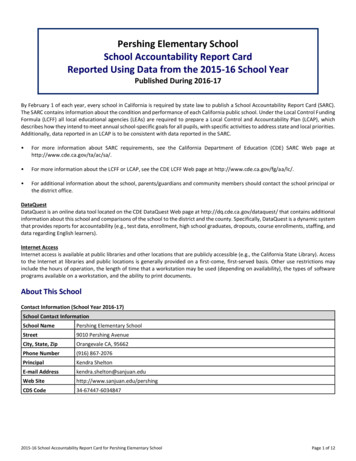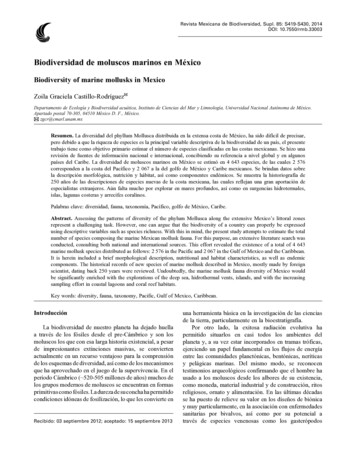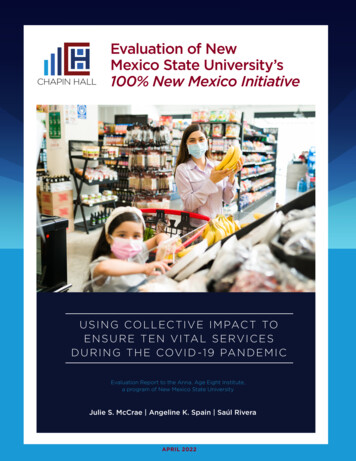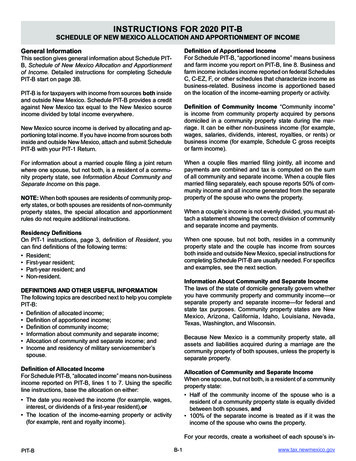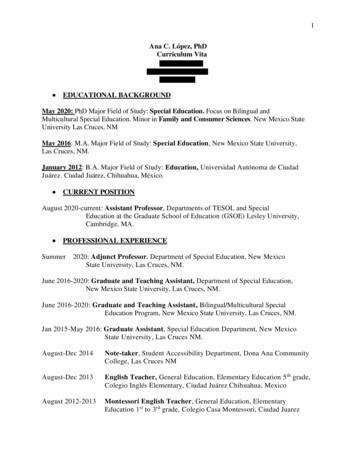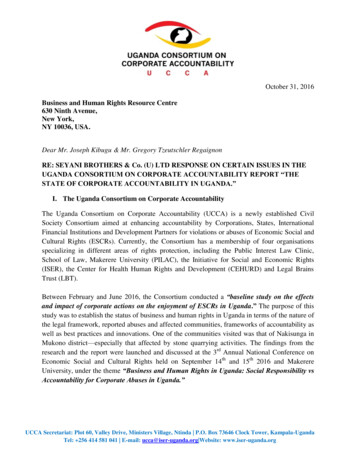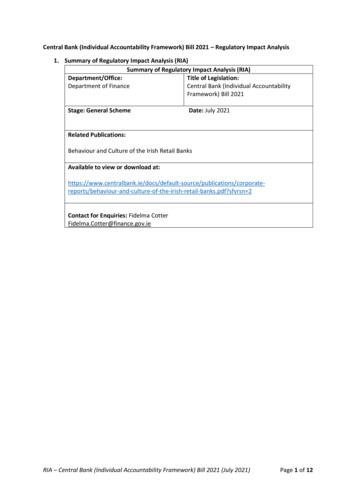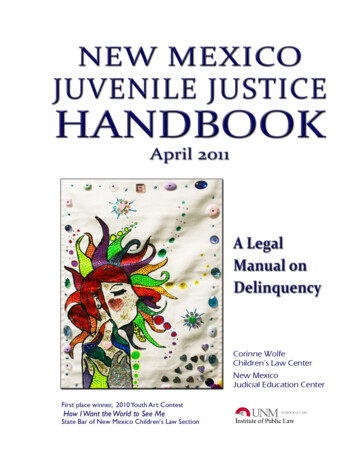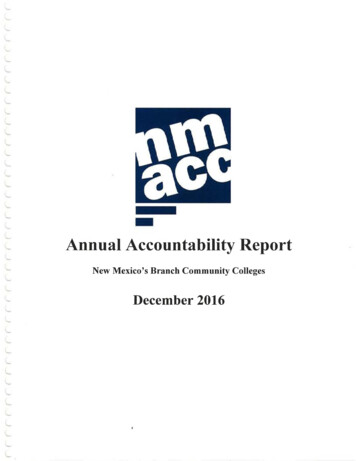
Transcription
Annual Accountability ReportNew Mexico's Branch Community CollegesI)ecember 2016
TABLE OF CONTENTSLetter from the PresidentJMessage from the Board of Directors4.Meeting Our Mission .Enrollment at Branch5CollegesStudent Characteristics.6.-.7Summary Tables for Performance Based Measures.8AccomplishmentsT2NMACC Membershipt4Dual Credit for Branch CollegesRemedial CoursesParticipation in Student Credit Hours20.2tNon-Credit'Workforce Training Courses.22Specialized Services to the Community28Distance Delivery Efforts3lNumber of Programs Offered32Partners in Economic Development.JJHosted Four Year ProgramsBranch Colleges Performance Based Measures.
LETTER FROM THE PRESIDENTThe New Mexico Association of Community Colleges (NMACC) is proud to share the2016 Annual Report with all of our stakeholders in the many services and programs weprovide. The NMACC has as its strategic commitment - to provide higher quality degreeand certificate programs and workforce development services. Quality programs andservices are essential for the proper preparation of New Mexicans to be competitive infacing economic opportunities and challenges. Quality is how we as branch communitycolleges want to be recognizedin the preparation of our students for the challenges oflife-long learning and career opportunities into the 21st century.This report profiles the member institutions of the Association and defines the progresseach has made in 2015-16 in the Performance Indicators. These data and measuresrepresent the progress each institution has made during this period and represent thesignificant social, economic and educational impact these ten institutions have on theirlocal communities, service areas and the state as a whole. The report reflects thedetermination and commitment of faculty, staff and administrators at the memberinstitutions to fulfill their missions and, ultimately, to ensure student success.In conclusion, the report should be viewed as a benchmark in the ongoing effort to bringquality education and training to as many citizens as possible through responsive,responsible, and effective means. This report is intended to be comprehensive and userfriendly. If you have suggestions regarding the report or desire explanations of the data ormethodology used, please feel free to contact us.Regards,Clayton Alred, PhDPresidentaJ
MESSAGE FROM THE BOARD OF DIRECTORSThe New Mexico Association of Community Colleges is a 501 (c) 3 nonprofit educational organization. Our mission is to support membercolleges in their efforts to provide New Mexico citizens high quality,affordable, and accessible post-secondary educationalopportunities.Accomplishing our mission requires collaboration and teamwork amongcommunity college faculty, staff, and students, with financialinvestment from New Mexico taxpayers. Engagement of legislatorsand residents within the communities we serve is vital to the successof our students.Branch Community Colleges are committed to providing cutting edgeeducational opportunities for aII students. As research bears out,the factor that is more closely correlated with upward mobility inour society is the level of educational attainment. As long aseducational achievement keeps up with technological gains, morejobs will be created.This report has been prepared to provide valuable information andfacts about the status of NM Branch Community Colleges.Please review the 2016 Annual Report and then feel to call upon us toanswer any questions you may have.NMACC Board OfficersDr. CluyÍon Alred, PresidentDr. John Grøtton, Vice PresidentDr. Renuy Scott, Secretury and TreasurerDr. John Madden, Pøst President
MEETING OUR MISSIONOur MissionNew Mexico Branch Community Colleges provide quality higher educationfor the communities we serve. We strive to create a shared teaching andlearning environment fostering student development, and supportingproductive citizenship in an ever expanding global and technological sociefy.Our Purposeoooeoo¡Offer general education and university transfer curriculumAward academic, and career-technical education associate degreesMake available continuing education, and workforce training programsOffer dual credit enrollment and early college studiesDeliver adult basic skill classes, English as a second language and GEDpreparationOffer cultural, social, and community eventsProvide comprehensive student and academic support servicesOur GoalsooooEnsure effective and efficient use of human, financial, and physicalresources in the delivery of education and servicesProvide geographical accessibility and affordable education to fulfiIIthepersonal, social, cultural, and economic potential of New Mexico's diversepopulationDevelop partnerships among public schools, colleges/universities, and theprivate sector to deploy coordinated educational opportunitiesDeliver quality education and workforce training programs to cultivate ahighly competitive workforceOur ValuesooooooExcellence in teaching, learning and serviceIntegrity as the foundation of our purposeInclusiveness of people and differing idealsCollegiality, collaboration, andcreativenessCommunity, leadership and innovationNurturance of students, others and our community5
ENROLLMENT AT BRANCH COLLEGESNew Mexico's branch communþ colleges, with a commitment to access and an opendoor admissions policy, aÍe the colleges of choice for many New Mexico collegestudents. This is evident by the continued growth in enrollment throughout the past tenyears. In Fall 2015124,052 students sought credit enrollment within the branchcollege system in New Mexico.Fall2 015Enrollments by Instítutíon (Credit Enrollment) :InstitutionHeadcountFTEENMU RoswellENMU RuidosoNMSU AlamogordoNMSU CarlsbadNMSU Dona AnaNMSU GrantsUNM GallupUNM Los AlamosUNM TaosUNM 05213,047As shown in the graph below, the branch colleges have experienced a significantamount of growth within the last ten years.Branch Credit Enrollment O21500Fall05Fall156
IStudent Ch aracteristics :A majority of community college students work, have family responsibilities, and needfinancial assistance to cover educational costs. Community colleges provide a variety ofquality educational programs and support services that enhance the quality of life for thecommunities and individuals they serve. In addition to credit classes, communitycolleges provide significant services through non-credit offerings that serve an additional90,000 New Mexicans. These programs will be detailed throughout this report andinclude:o Adult Basic Education;oooBusiness assistance;Continuing education; andPersonal enrichment.Ethnicity Proftle:In response to the Accountability in Government Act, student access and success is oneof the community college performance-based measures. The following informationrepresents the branch communþ college ethnicþ profile.Ethnichofile for BranchesBranch Ethnicity ProfileIHispanic:White:Native Whitetr Native American@IIBlackAsianOther7
PERFORMANCE BASED MEASURES FOR COMMUNITYCOLLEGES:Our state's community colleges are engaged in a number of accountability initiatives tomeasure our efforts at improving access and success of our students. The colleges havebeen in the process of identifuing performance indicators for the purpose of performancebased budgeting over the past few years. The colleges have established targets,implemented improvement strategies, and developed reports to track progress on theseperformance measures.Aset of performance indicators have been identified and include:oooooooooAcademic Quality/ Student Progress and Success: Percent of StudentsTaking Nine or More Credits on Entry Successful After Three YearsEconomic Impact: Percent of Graduates Placed in Jobs in New MexicoEconomic Impact: Graduates Placed in Jobs & Continuing EducationAccessible and Affordable Education: Percent Ethnic Minority of TotalEnrolledAccessible and Affordable Education: Percent Minority of TotalGraduates Selected Based on Service Area ProfileService to New Mexicans: Students Enrolled in College ProgramsEfficient and Effective Use of Resources: Percent of Programs HavingStable or Increasing EnrollmentsStudent Persistence: Percent of Students RetainedGraduation Rate: Percent of Graduates (201 I - 2014 Cohort)The New Mexico Association of Community Colleges submits the branch communitycollege performance-based measures annually to the Legislative Finance Committee(LFC) and the Department of Finance and Administration (DFA). Each college submitsdetailed information to NMACC. These reports include three-year average baseline datawith targets for each indicator. The branch colleges have updated Performance BasedIndicator reports to include strategic plans that put these measures into context.The following pages are a combination of the branch community colleges response to thedirectives of the Accorurtability in Govemment Act and requests contained in SJM 4 of apast legislative session. Our goal is to have baseline data over a three year period foreach measure.In cooperation with the institutions, NMACC will continue to improve the quality of theperformance data. The following are the branch community college performancemeasures that were identified and are currently being used by the institutions.8
BRANCH CAMPUS PERFORMANCE MEASURESPE,RT'O RMANCE RAST',II INTìTí-ATr R #IPercent of Students Taking 9 or More CreditsThat Are Successful After 3 Years56.70Á53.7%54.5% 54.9% 54s0Á53.s%52.60/o54.70/654.3%54.O%5t.t%FYOs FYO6 FYOT FYOS FYOg FY1OFYll IYT2FY13 FY14 FY1550.1%FY16PERFORMANCE BASED INDICATOR #2Percent of Graduates Places in Jobs in 9o/o66.5%FYOs FYO6 FYOT FYOS FYOg FY1O72.G%65.9%FYll FY12 FY1.3 FYt4 FY15 FY169
PERFORMANCE BASED INDICATOR #9Percent of Graduates Placed in Jobs & ContinuingEducation in S FYO9 FY1O FYllFYt2 FY13 FY14 FY15FY16PERFORMANCE BASED INDI CATO R #7Percent of Programs Having Stable or '6 ÁFYO3 FYO4 FYOs FYO6 FYOT FYOS FYO9 FY1O FY11 FY12 FY].3 FY14 FY15 FY1610
PERFORMANCE BASED INDICATOR #8Percent of full-time, first-time, degree-seeking students enrolled in a Falltermwho persist tothe following Spring .9%7t.6%FYOT FYOS FYOg FY1O FY11 FY12 FY13 FY].4 FY15FY16PERFORMANCE BASED INDICATOR #10Percent of Full-Time, F¡rst-Tame, Degree Seeking Students Who Completea Degree/Certificate in 150%of Timet3.5o.Á!3.8o/o t{.lo/oL4.2o/oL53%169%17.60/0t6.8o/ot5.8%FYOT FYOS FYO9 FY1O FYl1 TYI¿ FY13 IY14 FY15t5.o%FY16l1
ACCOMPLISHMBNTSExecutive Summury:Thefollowing section highlights the signfficant øccomplishments of the branchcommunity colleges duríng the 2015-2016 academic year.Adult Basic Education (ABE):ooooThe average cost per student at branch campuses is 512.00.Branch colleges serve 9,039 or 42%o of Adult Basic Education studentsstatewide. ABE student is considered enrolled after clocking 12instructional hours. An additional4,879 students were served by branchcolleges that participated in ABE services but did not earn 12 instructionalhours.1,456 students are on the wait list for ABE services by branch colleges.There are over 2,600 students on the wait list statewide.Dual Credit Enrollment:o Branch colleges provided dual credit coursework for 6,790 studentsthroughout New Mexico this past academic year.o Enrollment for dual credit programs has increased almost every year since1999. The total increase in enrollment since 1999 is 5,281 students. Thedata shows the major growth for dual credit enrollment has occurredwithin the last nine years with branch colleges almost doubling thestudents they serve within this timeframe. It is expected the enrollmentwill continue to increase in the years to come.o Five branch campuses increased their enrollment for dual credit in the2015-2016 year.aEnrollment:ooBranch colleges serve 24,052 students statewide in credit cowses.It is evident that branch colleges continue to grow. As a whole, branchcollege enrollment for credit bearing students has grown since 2005 withan increase of 1,546 students.aHosted Four Year Programs:o Branch colleges continue to broaden access for local citizens by partneringwith state supported universities. Bachelor and master degree programsare offered at branch campuses through distance education programssponsored by ENMU, NMSU, and UNM.aNew Mexico Career Clusters:o Branch colleges offer a total of 398 academic and career technicaleducation programs as classified through the New Mexico Career Clusters.t2
aNew Mexico Small Business Development Centers (SBDC):o Branch community colleges proudly support and host SBDC centers.Since 1992 over 14,801 jobs have been created through the efforts oftheSBDCs.Non-Credit \ilork Related Courses:oooBranch colleges served 14,977 in headcount for non-credit courses durinothe 2015 year.Branches contracted with an additional 393 new businesses and agenciesoffering workforce or customized training classes during 2015.Branch colleges generated 764,943 in the number of student contact hoursfor non-credit, work related courses for the 2015 academic year. This isan increase of 53,414 since the 2007 -2008 academic year.aPerformance Measures:o There continues to be improvement ¿ìmong new branch college studentstransferring or obtaining a degree credential (after three years), havingreceived a degree or certificate, transferred, became transfer ready, or arestill enrolled.o Since 2005, there was an annualized increase of branch communitycollege graduates placed in jobs in New Mexico. The branch collegeaverage in 2005 was 66.9Yo, which increased to 70.3%o in20l6.o The branch college statewide persistence average was7l.6Yo for collegestudents enrolled as full-time, f,rrst-time, degree-seeking students in Fall2015 who subsequently enrolled during the following Spring 2016 term.oService to the Community:o Branch colleges offer over 80 different services and activities throughspecial projects or courses (i.e. weekly courses, events, programs,services, and workshops) that enriched the community and residents livingwithin the college service area.Online and \ileb-Based Instruction:o 10,561 students enrolled in online and web-based classes at allparticipating branch campuses during the2015-2016 academic year. Thisfigure represents an increase of 6,412 students compared to the 2005-2006academic year.t3
NMACC MEMB ERSHIPEastern New Mexico University - RosweltJohn Madden, Ed.D., PresidentCollege District: Chaves Counfy575.624.7000roswell.enmu.eduEastern New Mexico University - RuidosoClayton Alred, Ph.D., PresidentCollege District: Lincoln County575.257.2120ruidoso.enmu.eduNew Mexico State University - AlamogordoKen Van Winkle, Ph.D., PresidentCollege District: Otero County575.439.3600nmsua.eduNew Mexico State University - CarlsbadJohn Gratton, Ph.D., PresidentCollege District: Eddy CountyNMSTA TEl\1,\lR\l)57s.234.9200cavern2.nmsu.eduNew Mexico State University - I)ona AnaRenay Scott, Ph.D., PresidentCollege District: I)ona Ana County575.527.7500dabcc.nmsu.eduWNMSU Doñ¡Á¡a Conmuniry ColleteNMSTATENew Mexico State Universitytìdo Nc ArbL-GrantsHarry Sheski, Ph.D., PresidentCollege District: Cibola County505.287.6678grants.nmsu.edut4
NMACC MEMBERSHIPUNMGALLUPUniversity of New Mexico - GattupChristopher I)yer, Ph.D., Campus Executive I)irectorCollege District: McKinley Countys05.863.7s00sallun-rrnm-edrrUNMr-os Ar-AMOSUniversity of New Mexico - Los AlamosCindy Rooney, Ph.D., Campus ExecutiveI)irectorCollege District: Los Alamos County50s.662.0344Ia.unm.eduUniversity of New Mexico - TaosMarty Hewlett, Pd.D., Interim CampusExecutive DirectorCollege District: Taos CountyUNMTAoS575.737.6200taos.unm.eduUniversity of New Mexico - ValenciaAlice Letteney, Ph.D., Campus Executive DirectorCollege District: Valencia County505.925.8500unm.edu/-unmvcNMACC EXECUTIVB DIRECTORdTy Trujillo, M.B.A.1239 Paseo de PeraltaSanta X'e, NM 87501Phone: (505) 982-9523nmacc.info15
DUAL CREDIT FOR BRANCH COLLEGESDual Credit in New Mexico:The New Mexico state legislature and the education community worked togetherin recent years to pass several bills to further the dual credit initiative. Senate Bill943 (2007) and Senate Bill 31 (2008) created a statewide dual creditprogramtoallow high school students to earn both high school and college credit forquâlifuing courses. In addition, Senate Bilt 561 (2007) required that all entering9"' graders shall earn at least one credit through one of the following: honors,advanced placement, distance learning, or dual credit. As shown in the databelow, the duøl credit ìnitiutive continues to grow statewide ønd partícularlywithin branch colleges.Dual Credit for Branch Colleges New Mexico:aThe total number of high school students participating in dual credit within thebranch colleges is 6.790.The number of dual credit students increased 4.994 since 1999-00.Colleges:Headcount:ENMU RoswellENMU RuidosoNMSU AlamogordoNMSU CarlsbadNMSU Dona AnaNMSU GrantsUNM GallupUNM Los AlamosUNM TaosLTNM ValenciaBRANCH TOTAL:1,2593993778971,15454639s3647436s66,790t6
A Look at the Historical Trends of Dual Credit:(Headcount)(iollegeE\\ttRosn ellt \\ltRuidoso\ Itst\lanro\\tst( ¿rlrbal)olta\nit\\tst(ìr'antst\\l(iallu pLos,\larn¡rst \\ll'ar¡st\\\l¿lenriaIotalsl-l)2 02-llj 0J-01 ll¡-05 l)5-06 i6-07 07-(xt t)tJ-09 t)9-lt) t0-tItt-12 t2-t3 4,8684,8125,5445,4707,3826,860ó,5856,790(lGrowth in Dual Credit Enrollment for Branches"rP"""*""f "f ""f ""tr""o"""SsotC"""t"d *f çf çff çft7
REMEDIAL COURSES TAKENBranch community colleges offer a signihcant number of remedial courses forindividuals who have not yet acquired basic skills sufficient to succeed at college-levelcourse work. Since our colleges are open to all who apply, they require prospectivedegree-seeking students and those interested in pursuing college-level English and Mathto be assessed for basic skill competency. Based on the assessment outcome, students arerecommended for college-level or remedial course work in pre-college skill buildingclasses in English, Math, Reading, or Study Skills. Remediation represents a significanteducational program effort at most institutions. Students who score below college levelmust successfully complete remedial courses before enrolling in college-level courses ina related discipline.o Of the total (2,042) 2015 high school graduates enrolled in branch communitycolleges, 1,066 needed remediation in Math and929 needed remediation inoEnglish.Of the total (500) students that graduated in 2015 with a GED and enrolled inbranch community colleges, 182 needed remediation in Math and lI7 neededremediation in English.The following chart shows the branch community college remedial efforts.Recent '15 HighSchool Grad.( E()ØÊq)v)(ÊoL()-ozó .Collegecs o)-òI)ôcdf- -3C)(Ê(ntrc)ËqroLottròno-Õzõ �nz1ÃCÚ C)-èoo(Út ()i Ëèo2 é¡i\29OE7 2tt6t230729-t4.93069268092541399tNMSU Dona AnaNMSU GrantsUNM GallupUNM Los Alamos89148025170Totals!Others(ËcËØC)ENMU RoswellENMU RuidosoNMSUAlamoNMSU CarlsbadUNM TaosUNM Valencia2015GED492755552214o63t- 0l82stt67J238J523lt272,042 1,06655tl929 500 182 tt7*ENMU Ruidoso AII students slarting ín Fall 2015taking Math or English were placed in a college level course.Additional support ís provided through lutoring and lab tímefor stutlents neetling ixtra helpcollege"o*pl"tínglevel Math or English.18
Remedíal C o urs es Continue d :Another measure of student success is how well students do in college-level coursesfollowing successful completion of remedial course work. In some cases, students takingremedial courses do better in follow-up academic courses than students who have nottaken any remedial course work.o The success percent of students taking developmental courses in English rangefrom72%oto l00o/o.o The success percent of students not taking developmental courses in Englishrange from4lYoto95%o.o The success percent of students taking developmental courses in Math range froml7%oto 90%.o The success percent of students not taking developmental courses in Math rangefrom50%oto 87Yo.Some institutions are experiencing greater success with remedial programs than others.Improved practices of tracking remedial students will provide needed information forremedial program improvement, including social and academic support services.o/oENMU RoswellEI\MU RuidosoI\IMSU AlamoI\MSU CarlsbadNMSU I)ona AnaI\MSU GrantsIIIIM GallupIII\M Los AlamosUNM TaosIINMValenciaSuccess23%25%45%22%o/oinSuccess in Colleee %r7%23%72%77%t9
PARTICIPATION IN STUDENT CREDIT HOURSaColumns 1, 3, and 5 of the chart below demonstrate the percent of Student CreditHours in the major three areas of course work offered at community colleges.oColumns 2,4, and 6 of the chart below demonstrate the actual numberStudent Credit Hours in the major three areas of course work offered atcommunity colleges.oAcademic CoursesoCareer CoursesoRemedial CoursesofCredit Hours and Percents for Fall2015ol,lrtstitu tionI.tNN,ttlRosu ellF]NNITIRuidosoN N,lStrA la rnoN NISTJ(la rlshatlNMSIil)orta AnaNN,TSTi(irarrtsT]NNI(ìa llu ptiNNl l-os;\ la nl osTJNNI'I-aosTINVaN,IlenciasclltlrAca lenr ic(-ou rses#S(lllnl,inAcatlernicCorrrsesscll# SCHol' SCllintnilt(la ree rCou rses(.'a ree(lt¡urrsesRenredialCourses# SCll inRernedialCou %22,56865V"2,02934%1,0680%l2100%3,1097 204ÙYr9, 77Yo1,190r00%17,57320
\üORIGORCE AND ECONOMIC DEVELOPMENTNon-Credít Courses:Community colleges provide the working adult with many opportunities to prepare forcareer advancement, to keep abreast of new technology, or to prepare to enter a newcareer field. These are all critical strategies for workers in today's economy. In additionto credit offerings, community colleges offer a wide range of non-credit, work-relatedcourses, primarily through contracts with businesses and industries and various stateagencies. Branch colleges offered specialized classes to enhance workforce andeconomic development to well over 9,000 adults.Non-Credit Offerings for Branch Campuses:Headcount of 10:8,5872010-20t1: t0,22220ll-2012:14,9472012-201312,950:2013-2014: 14,977oNumber of Student Contact Hours 010: 100,3702010-2011 110,373:2011-2012: 1t9,3062012-2013: 135,0012013-2014: 164,943.NTtrmha- nf NlorttEntities Hishlishts:aooBranch colleges sewed 14.977 in headcount for non-credit courses during the2015 year.Branch colleges generated 164.943 in the number of student contact hours fornon-credit, work related courses for the 2015 academic year.Branch colleges sewed393 new entities for non-credit courses during the 2015year.2t
PARTNERS IN ECONOMICEVELOPMENTThe branch community colleges have taken a leadership role in economic development intheir region and have developed innovative projects such as those listed below.Eastern New Mexico University Roswell:New Mexico Mesa, Inco New Mexico Mesa, a non-profit orgarization, is part of a national initiativepromoting educational enrichment for pre-college students from historicallyunder-represented ethnic groups. New Mexico Mesa prepares students for collegemajors and careers in math, engineering, science and related fields. ENMURoswell is providing office space and administrative support for a regional NMMesa office on campus. The campus also serves as a regional activity site forMESA.National Guard Youth Challenge Academy:o ENMU-Roswell partnered with the National Guard's Youth Challenge program in2001. The college provides career-technical education, food service and othersupport to the program, which targets high school dropouts ages 16 to 18 fromthroughout New Mexico. The 22 week academy gives cadets the opportunity tocomplete their GED high school equivalency diploma and 15 credit hours ofcareer-technical coursework through ENMU Roswell. Cadets also take part inphysical fitness activities, CPR classes, job skills training, and community serviceprojects.Xcel Energt Community Solar Program:o ENMU-Roswell has partnered with Xcel Energy to construct a community solarenergy demonstration site on Campus. The 35 kilowatt solar installationdemonstrates six photovoltaic (PV) solar technologies that can be installed onhomes or businesses, including rooftop, lollipop array, single axis array, and dualaxis a:ray. The project covers 22,000 square feet and includes a walking path withinformation markers describing the types of technology being demonstrated andinteresting solar facts. Meters also show the output of the power being generated.ENMU-Roswell's site is the largest of the company's four solar installations inSoutheast New Mexico. ENMU-Roswell students enrolled in the RenewableEnergy Technology program utilize the site for training and area school studentscan tour the site during the school year for educational field trips.Eastern New Mexico University Ruidoso:New Mexico Worlcforce Connection:o Provides basic adult education and workforce training opportunities to LincolnCounty.22
PARTNERS IN ECONOMIC DE VELOPMENTCONTINUED.south central Mountain Ec onomic Devel opment As s o ciation :o Important elements of the association is the collaboration between communities ina region, and provides economic analysis that is tailored to help capture theregion's current or emerging clusters and the college will assist in îhe workforcetraining.Rural Community College Funding Development Initiative:o The purpose on the initiative is to better identify and acquire financial resourcesand create economic development opportunities.New Mexico State UAlamogordo:Alamogordo Committee of 50:o This group is pursuing the continued presence and expansion of the federalfacilities in the region, including Holloman Air Force Èase and V/hite SandsMissile Range.Otero County Economic Development Council:o NMSU Alamogordo is a partner with the OCEDC in recruiting new businesses tothe area and promoting the local Gross Sales Tax increment for local economicdevelopment.Alamogordo Chamber of Commerce:o NMSU Alamogordo is active in the Alamogordo Chamber of Commerce in itssupport for local business ventures involving students and the public.New Mexico State UCarlsbad:Carlsbad C ommunity D ev el opment C orp or ati ono NMSU Carlsbad offers a progr¿ìm in Building Trades and ConstructionTechnology where college and dually-enrolled high school students construct ahome which is then sold, through the Carlsbad Community DevelopmentCorporation, to a low-to-moderate income family. This partnership assists indeveloping a well-trained workforce in addition to meetingã need foi affordablehousing in Carlsbad.Contract Training:o NMSU Carlsbad Continuing Education and Contract Training department assistslocal businesses with their professional development and/oishort-term trainingneeds by providing low cost, high quality customized training coì.yses.23
PARTNERS IN ECONOMIC DEVELOPMENTCONTINUED.Small Business Development Center :o The Small Business Development Center (SBDC) at NMSU Carlsbad works withsmall business and prospective business owners to assist in developing short-termand long-term business improvement strategies; to develop business plans and/orforecast models to assist small businesses in seeking long-term financing; and toperform local and regional marketing and economic forecast surveys.New Mexico State University Dona Ana:Mesilla Valley Economic Development Alliance (MVEDA)o As the leading economic development organization in Southern New Mexico, themission of the Mesilla Valley Economic Development Alliance (MVEDA) is to"Grow the wealth of Doña Ana County through the creation of economic-basedjob opportunities for its residents." MVEDA is a public/private sector economicdevelopment alliance that serves all of Doña Ana county (Las cruces NM MSA).Bridge of Southern New Mexico:o The Bridge is an innovative public-private partnership between the top leaders inbusiness, economic development, government, and education that promotescollaboration coÍtmunity-wide and leverages the resources of their group toidentifu and implement effective, measurable change. V/orking at a uniquemoment in New Mexico's history, The Bridge is perfectly positioned o be theepicenter of educational change for Doña Ana County, the state, and ultimately,the country at large.Worlcforce Center and Various Economic Development Organízations:oSome of the partners t
Number of Programs Offered Hosted Four Year Programs Branch Colleges Performance Based Measures. . . 22 28 3l 32.JJ. . PhD President aJ. MESSAGE FROM THE BOARD OF DIRECTORS . NMSU Dona Ana NMSU Grants UNM Gallup UNM Los Alamos UNM Taos UNM Valencia Total 2,657 655 1,904 1,931 8,334 1,048 2,483 965


